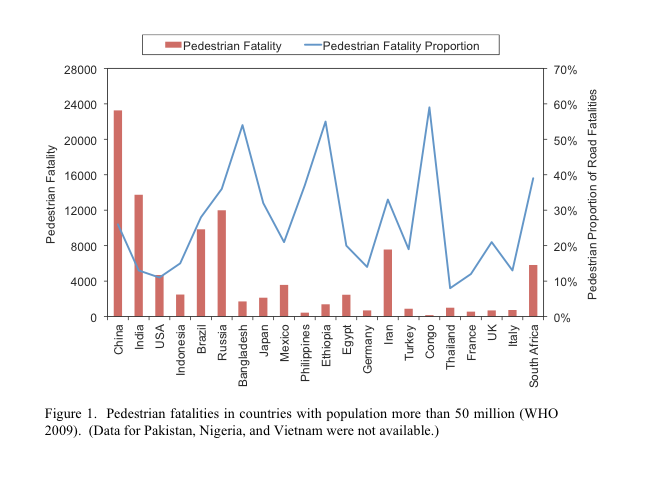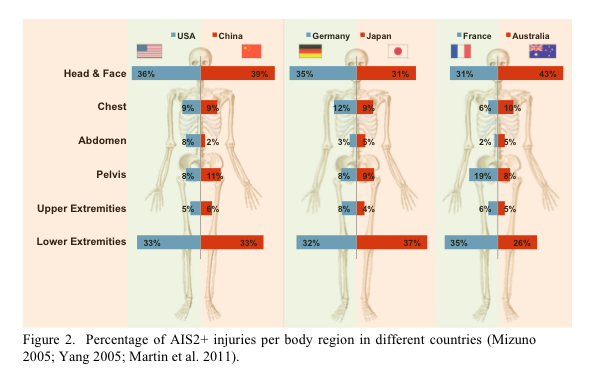UNIVERSITY OF MICHIGAN- TRANSPORTATION RESEARCH INSTITUTE
Introduction
Due to the rise in global urbanization and motorization, pedestrian injuries continue to be a major public-health problem worldwide. Every year over 1.2 million people die and 20 to 50 million people are injured in motor-vehicle crashes around the world, and pedestrians account for more than a third of them (WHO 2009). The proportion of pedestrians among road-traffic fatalities varies significantly in different countries (Figure 1), ranging from more than half in Africa to 15% or less in North America or Europe (Naci et al. 2009). The distribution also varies across countries with different income levels: 45% of road fatalities in low-income countries are pedestrians, whereas an estimated 29% of road fatalities in middle-income and 18% in high-income countries are pedestrians (Naci et al. 2009). As an interdisciplinary research problem, reducing pedestrian injuries needs a systematic approach, including safer facilities for pedestrians through engineering, safety laws with stronger enforcement, and higher public awareness through education (Zegeer and Bushell 2012). Historically, the benefit of designing a pedestrian-friendly vehicle was neglected primarily due to the societal perception that pedestrians are too vulnerable in a collision with a vehicle (Fisher and Hall 1972; Crandall et al. 2002). However, since the 1970s, and especially during the last two decades, field data analyses, pedestrian crash tests, and computational simulations have all shown that vehicle design has significant effects on pedestrian injuries.
This report provides insights into vehicle design and new vehicle-safety devices for improving pedestrian safety. The report starts with a summary of pedestrian-injury distribution, causation, and risk factors. A discussion follows on current pedestrian impact tests and the safety features specifically designed for reducing pedestrian head and lower-extremity injuries. Design evaluation and benefit are estimated for each safety feature. The report concludes with a discussion and recommendations.
Pedestrian Injuries
Real-world pedestrian-injury data provide first-hand information about patterns, causation, and risk factors of pedestrian injuries, and valuable background for improving vehicle design for pedestrian protection. However, pedestrian accident databases with in- depth investigation on both crashes and injuries are available for only a small number of developed countries. These include the U.S. Pedestrian Crash Data Study (PCDS) (Ivarsson et al. 2005; Zhang et al. 2008; Helmer et al. 2010), the German In Depth Accident Study (GIDAS) (Fredriksson et al. 2010; Otte et al. 2012), and the European In Depth Pedestrian Database APROSYS (Advanced PROtection SYStems) (Carter et al. 2008). The International Harmonized Research Activities Pedestrian Safety Working Group (IHRA/PS-WG) combined recent pedestrian-injury data from Japan, Germany, United States, and Australia, and denoted it as the IHRA Pedestrian Accident Dataset (Mizuno 2005). It is the most comprehensive dataset for pedestrian injuries thus far, but does not include data from developing countries. More recently, China has collected in- depth pedestrian-accident data at a regional level (Kong and Yang 2010; Zhao et al. 2010), which provided an opportunity to compare pedestrian-injury rates among high- income and middle/low-income countries.
Read full report (PDF) here: Toward Designing Pedestrian-Friendly Vehicles
About The Transportation Research Institute at The University of Michigan (UMTRI)
www.umtri.umich.edu
“The Transportation Research Institute at The University of Michigan is committed to interdisciplinary research that will ultimately increase driving safety and further transportation systems knowledge. UMTRI is currently operating a research program with $13.7 million in expenditures, with funds received from federal and state government agencies, motor vehicle manufacturers and suppliers, and other organizations.”
Tags: Transportation Research Institute, UMTRI, University of Michigan








 RSS Feed
RSS Feed